Trash Talk
“I am known for walking with my eyes to the ground. This may be taken by some as evidence of my melancholy character. To my Edwardian great-aunts, it would have been evidence of future posture and moral problems; a sign that I might not be fit for the muscular, Christian manhood that the imperial projects their own childhood required.”—William Ramp
Small Things Recollected
By William Ramp
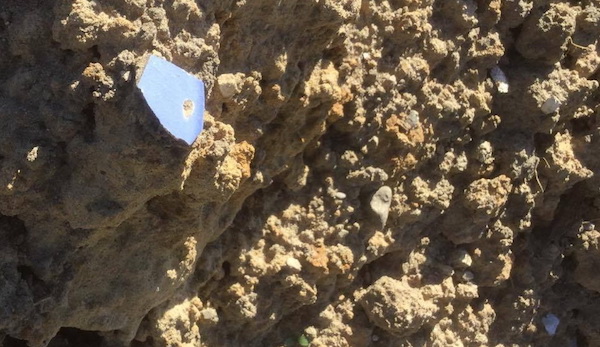
 LETHBRIDGE Alberta, Canada—(Weekly Hubris)—August 2017—This month, I’m pondering useless things. I’ve dealt with big themes and issues over the past year, but I want to get back to the spirit of my banner title, “Small Things Recollected,” which plays on the title of a lovely and classic archaeological text about humble things: James Deetz’s In Small Things Forgotten.
LETHBRIDGE Alberta, Canada—(Weekly Hubris)—August 2017—This month, I’m pondering useless things. I’ve dealt with big themes and issues over the past year, but I want to get back to the spirit of my banner title, “Small Things Recollected,” which plays on the title of a lovely and classic archaeological text about humble things: James Deetz’s In Small Things Forgotten.
The dramatis personae of this column are discarded items so forgotten that perhaps they no longer even count as trash. Or even as “items.” Useless beyond description. I’m daring myself to make the result interesting to you. Truth and dare.
On a recent trip to southern Ontario, I discovered that the main street of my home town was being torn up and re-paved. I had to go on foot behind a barrier to access a drugstore. On my uneven way, I passed a mound of backhoe-disturbed clay, an unlovely and all-too-common feature of the modern urban landscape. Something’s always being torn down or dug up. But this sight caused me to back up, look around, stoop over, crumble clay between my fingers, and take pictures. It also activated a fragment of early archaeological training, and a personal predilection.
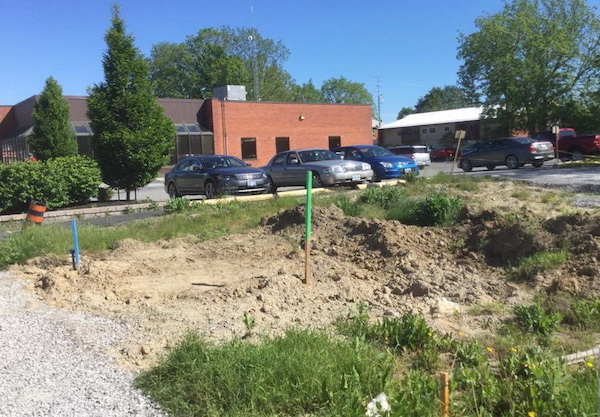
I am known for walking with my eyes to the ground. This may be taken by some as evidence of my melancholy character. To my Edwardian great-aunts, it would have been evidence of future posture and moral problems; a sign that I might not be fit for the muscular, Christian manhood that the imperial projects their own childhood required. I suppose there’s a certain truth in that. I have become more and more fascinated by the detritus of Empire; its complex intermixture of dreams, projects, conflicts, cultures, and horrors, many of the details still resting in archives and attics, memory and infrastructure, attitudes and earth.
I find inhabited ground interesting. Dig into it, and you find a storehouse of things lost, buried, hidden or left behind. The deeper, the older: by the age of ten, I was already alive to the stratification revealed by cuts and excavations. But the surface, too, is a text of a past not completely erased. Anonymous humps, hillocks, hollows, furrows, arrangements of boulders, orders of trees, clumps of bushes, protruding concrete or brick; all these speak ambiguous but revelatory things about the intersection of human activity, geology, and time.
I readily admit that this fascination is not a matter of curiosity alone.
Nicholson Baker writes: “I’ve always had an urge to try to hold on to places and documents and buildings. If a store went out of business when I was a kid, I’d have a horrified, grieving feeling. How could it be gone? What was the shopkeeper going to do now? I don’t like when precious things slip through people’s fingers—especially things that seem defenseless or under-celebrated, like old newspapers, but also unheralded people who may have said sensible things at a certain time in history, but who were completely drowned out by other people. Or minor poets whose lives were instructive. Sometimes I’m astounded by the absence of sentimentality in other people. How can you not become attached to the poignant scraps that flow through life?”
I’m with Baker in having an attachment to forgotten things; a sense that people can be forgotten easily, too; sensing a resonance with them.
I volunteered one high-school summer at an archaeological dig in southwestern Ontario. We were assigned to a midden (another word for a cache of discarded objects; a garbage dump, if you will). It was a relatively safe place to set neophytes to work; we would be unlikely to miss the dark round patches in the earth that identified a long-rotted palisade or longhouse wall. But this downmarket location held a fascination of its own: one traded big-picture expectations for the sheer pleasure of the unexpected and idiosyncratic.
One of the archaeologists on site took me field-walking on the surrounding farm. She explained delightedly that on land that has been tilled or otherwise disturbed, after a good rain, artifactual bits and pieces will often stand out from the soil on tiny pedestals; miniature thrones hinting at an underground kingdom.
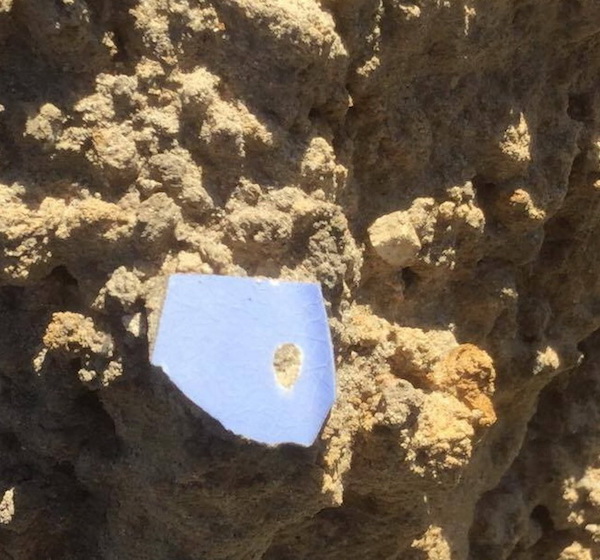
In short order, my cursory look around the backhoe’s deposit produced a small collection of broken fragments datable to the 19th and early 20th centuries. There’s no way now to tell their exact location before they were dug up and dumped, but their likely source was either a long-gone house and yard, or the street, itself. Diagonally behind the mound of earth was once a service station. Before that, at some point, there were residences. The earlier these were, the more likely they were to be closer to the road.
Thoroughfares can be equally important archaeologically as households or other building sites. We tend to think in terms of place and location, seeing roads and streets merely as ways to and from them. But a lot happens on roadways, good or ill. Things are lost or thrown away on them. Their direction and alignment tell stories, and the construction of present roads is often layered over the macadam, gravel, corduroy logs, and mud of the old.
Main Street, in my home town, is no different. The settlement history of Port Dover began from watercourses and trails. The surrounding area, often described as “heavily forested” in later accounts, was actually broken by oak plains, open areas amenable to deer-corrals, berry harvesting, indigenous agricultural communities, and regular trade by water and footpath. For several centuries, this was the homeland of the Neutrals, an Iroquoian agricultural and trading people, called Attawandaron (“people whose speech is a little off”) by the neighboring Wendat (aka “Hurons”). In the 1650’s the Iroquois Confederacy to the east declared war on the Neutrals, who, weakened by epidemics, were quickly overwhelmed and scattered. The Wendat, in turn, were dealt a similar fate. In the following century, the land was lightly reoccupied and hunted over by the Mississauga, an Anishinabek people with whom the British signed a treaty in 1784.
The mouth of the Lynn River at the future site of Port Dover provided shelter and respite from canoe travel along Lake Erie for the missionaries François Dollier de Casson and René Bréhant de Galinée in the winter of 1669-70 and, over a century later, hosted the first European squatter. Early east-west roads along the lake shore likely followed the course of First Nations trails: at the east and west outskirts of Port Dover are remnants of an old lake shore road, now lost in parts to erosion. Running alongside the river, another early road led inland, linking the river mouth to a grist mill settlement established about 1804. Dover Mills’s main claim to fame was its destruction in a cross-lake American raid in 1814, said to have been avenged by the British burning of the White House later the same year.
Main Street, as it now exists, runs arrow-straight north from the modern harbor to a point just west of the old Dover Mills (see 1880 township map). It was laid out in 1835 on the lands of Israel Wood Powell, a merchant whose economic well-being was tied to improvement of the harbor, and Moses Nickerson, a peripatetic early Mormon (baptized by none other than Joseph Smith), and latter-day Methodist. Main Street follows the high ground to the west of the river, and thus likely intersects in places with an earlier trail. But the geometric and material improvements that Powell and other town promoters sought to impose on the land were not easy to enact. Access to Main Street from across the river was through a swamp, necessitating a turn up an adjoining street (still commemorated colloquially as Dump-Swamp Corner). The harbor, in turn, needed a sandbar removed, piers, and a lighthouse.
By the advent of a wheat boom sparked by the Crimean War, these amenities were all in place. Lines of wheat wagons stretched along the street and out of town, and taverns every mile or so made teamstering them lighter, if more dangerous work. The arrival of the railway in the 1870s reoriented the economic focus of the town away from the Erie shore and toward the inland industrial centers of Hamilton and Brantford. But the freshwater fishing industry still corrals the town into a binational community of lake ports, and Main Street is still part of a provincial highway system.
The key thing about the street from an archaeological point of view is that it was not paved until the 1920s. In other words, until less than a century ago, things dropped or tossed along its length, if not retrieved by human or canine scavengers, were likely to become embedded in the ground, emerging as fill scraped off by graders or tossed up by later road-building equipment.
So what did I find? Nothing at all important; no coins or other treasures. Not a single un-broken item. But here they are, laid out on notebook paper and bedspread, temporarily removed from their clay matrix, no longer glinting in the afternoon sun.
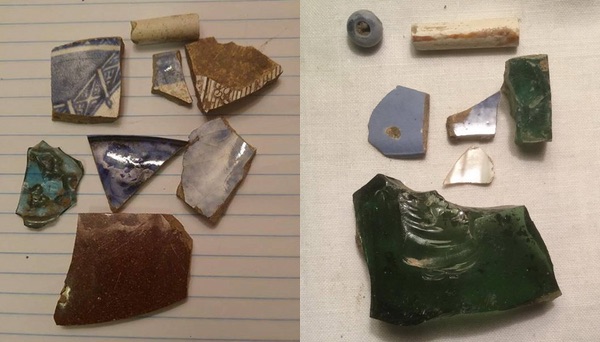
What are they?
– One shard of thin embossed glass
– Several bits of crockery and china
– Two clay pipe stem fragments
– Two pieces of thick, dark-green glass, likely from an early-20th-century electrical pole insulator
– A fragment of the shell of a freshwater clam
– A blue glass bead
Disappointed?
Read on: here are some questions they inspire and stories they hint at.
The embossed glass is quite likely from a patent-medicine bottle, dating from a time when over-the-counter medicines often had a sometimes intoxicating, sometimes deadly punch, and when the companies that made them sponsored traveling entertainment shows that rivaled circuses in popularity.
Blue and brown patterned crockery and china was popular throughout the 19th century; the brown piece likely dates from the 1870s or ’80s, while some of the blue ones could date earlier. The heavier pieces are glazed plain white on the back. The term “china” used for ceramic dinnerware bespeaks the inspiration for the pattern now known as Blue Willow. Decorated Chinese ceramics produced for export in the 18th century were being copied and mass-produced by English pottery firms as early as the 1780s. Items such as these, well before the railway, were easily transported from New York through the Erie Canal and transshipped by lake schooner or steamer from Buffalo to dry goods merchants in any of the Erie ports. They became heirlooms in many farm or town households, or broken shards tossed out and buried beneath gardens or pathways.
The pipe stem pieces represent one of the commoner semi-disposable items of the 18th and 19th centuries; cheap and easily broken. They also speak to conviviality among men. But not only men smoked them. My great-great grandmother smoked a clay pipe in front of the fire; a pastime her Victorian grandchildren attested to with some embarrassment. Before the great end-of-century moral, temperance, and social hygiene movements, pipe-smoking women were relatively unremarkable.
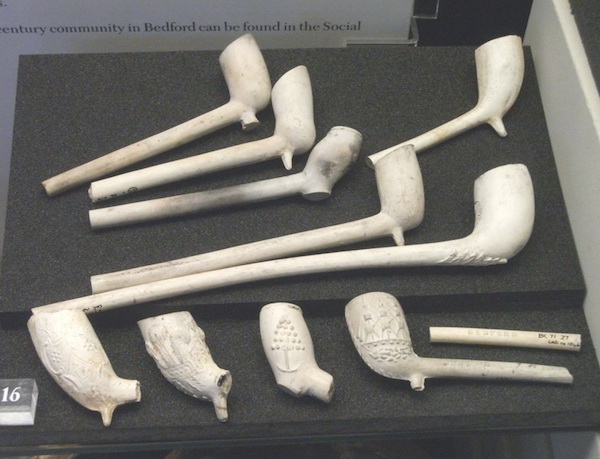
The piece of clam shell (technically, from a freshwater mussel) consists of the nacreous (pearlescent) layer only. It’s an unremarkable find in a port town, though one might wonder at finding it well above the beach or the river. Historically, Lake Erie was home to over 30 species of freshwater mussels, part of the diet of First Nations and early settlers alike, though less palatable than their saltwater cousins.
But in the 19th century, a great extractive pearl rush led to the decimation of lake and riverine mussel populations. Freshwater pearls were one draw, but the real mother lode was the nacreous lining of the inside of the shells, used in the mass-manufacture of mother-of-pearl veneers for everything from buttons to organ stops.
In the 20th and 21st centuries, pollution, drainage, and fill operations (such as that which put paid to the marshes at the foot of Main Street) and, most recently, invasive species, have made freshwater mussels among the most endangered of Great Lakes fauna.
The blue glass bead held my interest most of all these pieces. Why? Partly, because such items were made to be seen. Partly, also, because it has a hole through it. Beaches at Brighton, and on other shores with the right geologies, often turn up pebbles with holes worn through them, and they are objects of fascination, often strung and worn, as are beads. Glass-beaded costume jewelry, just like willow pattern china, mother-of-pearl, and clay pipes, were ubiquitous items of mass consumption in the 19th century.
But the history of the mass-produced glass bead is much older and more momentous than this. Inexpensive glass beads, manufactured in Venice from the 17th century, became the currency of burgeoning trade between Europeans and indigenous peoples, including the infamous purchase of Manhattan Island by the Dutch. This event has long been a stock-in-trade in condemnations of European land and resource robbery during the early colonial era.
That robbery richly deserves rebuke, but the story of the Manhattan Purchase has had the unfortunate legacy of representing the Lenape people who “sold” the island as mere dupes. They were not. As Aja Raden writes in a recent popular treatment of the subject, they knew what they were doing, and the value of the beads needs to be measured relative to both the political and economic value of other things they and the Europeans traded for in correspondingly vast networks.
Is this bead a trade bead? I’m doubtful. It’s certainly not early. But one can dream the dreams it evokes.
Finally, the dark green glass. Glass insulators are a collectible rage these days, and abandoned rail lines across North America are quickly being stripped of their remnant population, along with the valuable copper wire they still sometimes support in sagging, orphaned strands. This is, if you will, heritage resource extraction on an industrial scale.
Such insulators came in all kinds of colors, sizes, and shapes, and were used to handle a variety of lines: telegraph, telephone, and electrical power (which arrived in Dover via a local generator in the 1890s). They were essential to the age of electricity and to the transformation of the night and of work. But beginning in the late 19th century, the superior insulating capacity of ceramics meant that the production and installation of glass insulators declined. Still, where there has been no corporate-driven campaign to replace them, they may still be found in long-term local use.
Glass, traditionally, has been made with sand. But today, sand is a commodity in a different market; a global one so overheated by an Asian construction boom that sand-scarcity has become an international economic issue. East and north of Port Dover stretches a post-glacial sand plain. International sand pricing has visited it lightly thus far. But the odd landowner has found a way to make some income, and a more level surface for the imprint of mechanized agriculture, by leveling hillocks. The sand plains are announced a mile east of Port Dover by Duncan’s Hill, a low rise nibbled by sand excavation and named after my grandfather, great-grandfather, and great-great grandfather, all of whom farmed there.
There was one more set of items present in this street-side dirt pile, generally the same color of the earth, except for one that shone white in the clay. These were bones; one, a fragment of mandible with a still-extant row of very human-looking teeth. I took photos of them in situ. An inward shudder kept me from removing them for a better shot.
I’m no forensic anthropologist, but I soothed myself with the knowledge that the back molars of medium-sized animals, from large dogs to small ruminants, do easily get mistaken for human on occasion. Still, I sent the photos to a couple of anthropologist friends with a studiedly-casual query, and I will likely swallow my reservations and send them to the local police, too.

Finding human bones at construction sites is not unusual. If the ones I noted were animal (as I think they were), they could speak to a wide variety of animal parts, including heads and offal, that were purchased from 19th-century butchers to boil. Or they could speak to home butchery practices, or to the burial of a watchdog or other domestic animal.
As I turned away, a curious construction worker on the other side of the safety fence accosted me. I explained what I’d been doing, and we engaged in a short, friendly conversation through the fence. I mentioned the bones. He laughed, and said, “Well, dig down a bit further and you might find my ex-wife.”
Sometimes, the safety fence between present and past, between jest and horror, becomes suddenly, and uncomfortably, fragile.
Much effort in ink and wind has been expended over the past two centuries to shore up another kind of fence; between the human and the animal. The materials used in this construction include various assertions of human uniqueness: that we alone produce tools, that we alone produce our environments; that we alone produce symbols and cultures. Gradually, we are repenting of this labor, seeing what crows, magpies, parrots, dolphins, the great apes, and even cows and pigs can teach us about sociability, communication, and co-operation.
Unfortunately, while social media is full of such repentance, it is also full of fence and wall-building, and people in positions of great power have implied that their enemies (real or imagined) are subhuman or not-human, and have treated them like discards, to be fenced off in what they must imagine to be regional or national-scale landfills.
If anyone still wants to make a reasonable case for human uniqueness, I might suggest this: We are not the only animals to leave traces of our lives in the ground. But we humans are prodigious discarders. Especially now, we are caught in a present-day system of production-to-excess that encourages us to ignore our mortality and to treat waste as inevitable and inscrutable.
This human tendency has been a boon to archaeologists but increasingly a bane to the environment. The way we discard has changed greatly since the small fragments I have written about here ended up in the earth. When streets are paved, discarded things no longer sink gradually into the earth but are washed into giant sewer systems. Discarding, since the 19th century, has become a target of moral-reform and hygiene movements. It has become subject to intricate state regulation. But it has also become an enormous public/private/organized-crime industrial system. Discarded items end up in huge, centralized landfills, holding ponds, deep storage, or illegal dumps. And the materials that large disposal systems handle (well or badly) have become more chemically complex; their interactions with watercourses, soils and living bodies often not well understood. Think persistent organic chemicals, radioactive materials or plastics, for example. Think microbeads and microfibers.
It is a conceit of modern humans to ask what an archaeologist of the future might make of our material remains, from local landfill sites to the ship-beaching salvage yards of coastal India. There’s a concealed wish for immortality here: that even if our civilizations or our species might go extinct, we can still speak to some future about ourselves, even if the messages we might leave are unintended and reflect badly on us.
I think I’ll not worry overmuch about what folks of the future might make of us. I’d rather recall the things that have passed beyond our attention; the things to which we pay least attention. I’d rather look for the poignancy of things. But also the lessons they might whisper not only about their world, but about our present state; how it came to be; how it may end; what we might still be able to learn and to do.

Illustration Credits
All images, save No. 6, taken by the author.
Image 6 is by Simon Speed, 2010, from the collection of the Bedford Museum; on Wikipedia, at https://commons.wikimedia.org/wiki/File:ClayPipesBedfordMuseum.JPG, public domain.
Note
“. . . an Anishinabek people with whom the British signed a treaty in 1784.”
This was Treaty 3, also known as the Between-The-Lakes Purchase. What is often left unsaid in the older standard histories is that the “Beaver Wars” of the mid-17th century, which left the land around Port Dover lightly occupied by indigenous peoples for more than a century, was a knock-on consequence of European-origin disease epidemics, and of rivalries between New France and the New England colonies, which mostly destroyed a relatively peaceful political ecology between the First Nations of the lower Great Lakes.
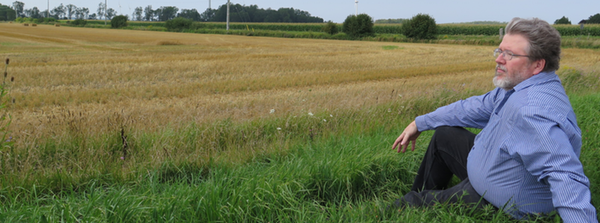
5 Comments
Elizabeth Boleman-Herring
Bill, I have my Cherokee grandfather’s “Indian trade beads”–just four or five of them, on an ancient piece of string–which date from . . . I have no idea, but sometime in the 18th or 19th century. One of them is blue, and “glass,” and one day you shall see it…. It’s one of the most precious things I possess, and was found at the bottom of a little wooden traveling trunk, along with a great-grandfather’s Confederate coat buttons.
Anita Sullivan
Bill, this sounds like the core of a book that might be called “The Way We Discard.”
I am tempted to address you as “my fellow poignant scrap”! Making a garden in my front yard has led to the unearthing of many mysterious fragments — wish you were here to give me ideas about what they might be!
Will
This urge toward archaeology is a trait I much admire in others, enjoy in myself, and am delighted to learn you possess. Unplumbed depths yet to be revealed in these pages, I’m certain! I must point my friends in Hamilton to this essay.
William Ramp
I apologize for being so late in responding to these wonderful comments.
Anita, I’ll address yours first. I would delightedly accept the title of fellow poignant scrap. But any book I might write on the subject would need to be coauthored with you.
Dear readers, if you liked my piece at all, please, please now go read Anita’s “Unearthing,” here: https://weeklyhubris.com/unearthing/
William Ramp
Elizabeth, I am sure you knew that your response; especially the words “at the bottom of a little wooden travelling trunk,” had me taut as a leashed terrier confronting a rodent hole. I have opened similar trunks and I know the encounter with things that whisper in a language just below the register of hearing. I shall, I must, see that string of beads!
Will, it’s my firm belief that the “urge toward archaeology” is central both to the psyche and to its mythos, though my archaeological colleagues (within spitting distance of my office along the same hallway) would urge upon me the scientificity of the discipline post-Schliemann! But all good science is inspired as well as methodical.
I do hope your Hamilton friends enjoy the piece. Hamilton is a city I love and lament; deeply layered in human and geological history.